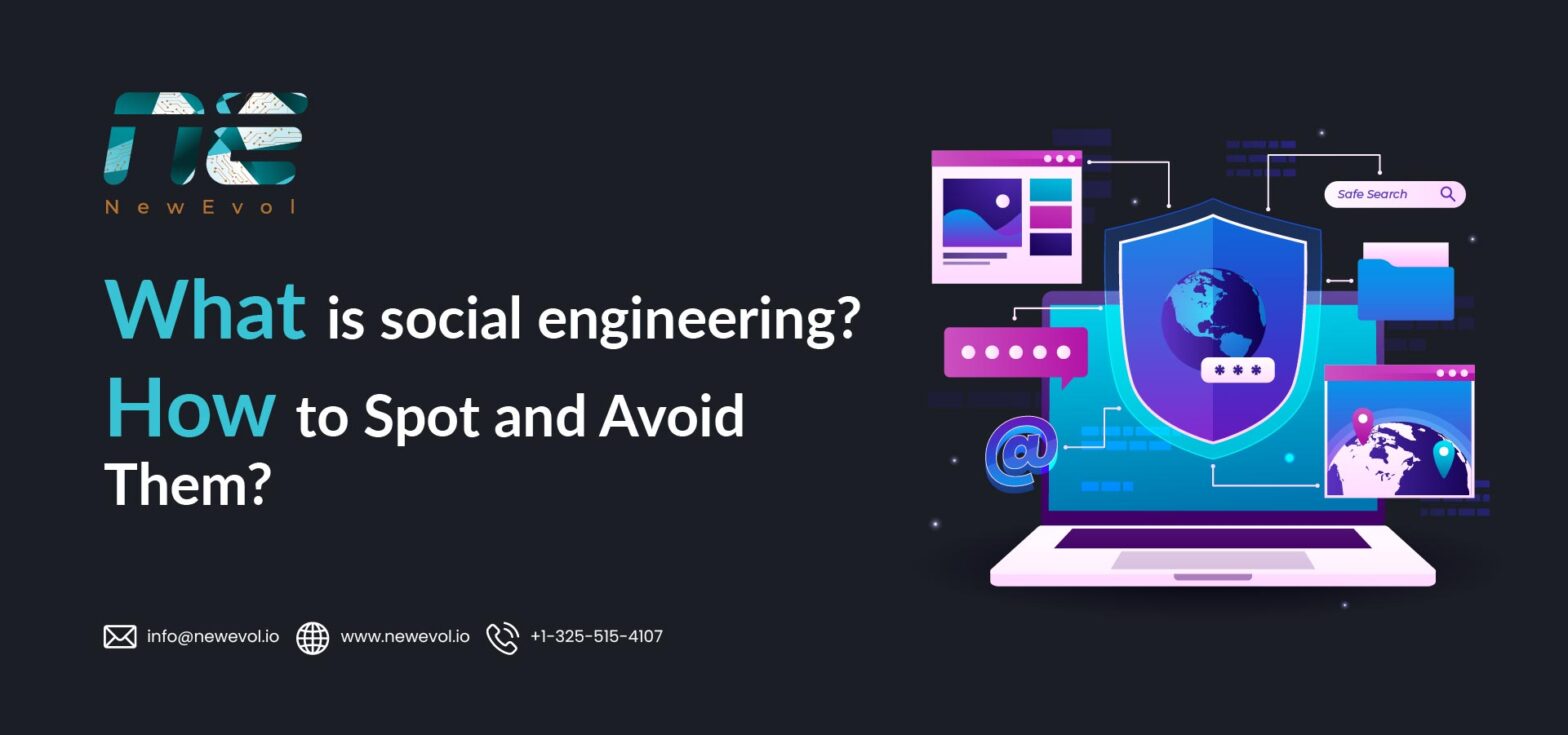What is social engineering? How to Spot and Avoid Them?

Social engineering is all about tricking people into giving up sensitive information or access. Instead of breaking into systems with technical hacks, attackers manipulate human behavior—using emails, phone calls, messages, or even in-person tactics.
In the U.S., social engineering is one of the most common ways hackers gain access to business networks, healthcare systems, and personal accounts. It can lead to financial loss, data breaches, and reputational damage.
In this blog, we’ll explain what social engineering is, the common tricks attackers use, and how you can spot and avoid them to keep yourself and your organization safe.
What is Social Engineering?
Social engineering is a type of cyberattack where hackers manipulate people rather than systems. Instead of trying to crack passwords or exploit software vulnerabilities, attackers exploit human trust, curiosity, or fear to gain access to sensitive information or networks.
In simple terms, it’s tricking someone into giving away what they shouldn’t—like login credentials, personal information, or access to secure areas.
The reason social engineering is so dangerous is that even the strongest technical defenses can fail if someone is fooled. Humans are often the weakest link in cybersecurity, which is why understanding these attacks is so important.
Common Social Engineering Attacks
Attackers use a wide variety of tricks to manipulate people. Understanding the most common social engineering attacks can help you spot them before it’s too late:
1. Phishing & Spear Phishing
Phishing is when hackers send emails, text messages, or social media messages that look real but are fake. They might ask you to click a link, download a file, or enter your login credentials. Spear phishing is more targeted, aimed at specific individuals, like executives or IT staff, and often uses personal information to make the message seem trustworthy. These attacks are extremely common and are often the first step in bigger cyberattacks.
2. Pretexting
In pretexting, attackers create a fake scenario to trick you into giving out sensitive information. For example, they might pretend to be IT support asking for your password, or a government official requesting confidential documents. The key here is that they build a story or context that seems believable, which makes people let their guard down.
3. Baiting
Baiting involves offering something appealing to lure victims into a trap. It could be a free download, a USB drive left in a public area, or an enticing offer online. Once the victim takes the bait, malware can be installed on their device, giving hackers access to sensitive systems.
4. Tailgating / Piggybacking
This is a physical social engineering tactic. Someone follows an authorized person into a secure area without permission. They might carry a stack of papers and politely ask someone to hold the door, exploiting human politeness. Even with strong technical security, this tactic can let attackers bypass locks and enter restricted areas.
5. Quizzes, Surveys & Social Media Scams
Hackers often use online quizzes, surveys, or fake social media promotions to collect personal information. You might think it’s harmless fun, but the data can be used to guess passwords, security questions, or launch targeted attacks.
6. Vishing (Voice Phishing) & Smishing (SMS Phishing)
Vishing involves phone calls where attackers impersonate trusted authorities, like banks or government officials. Smishing uses text messages to trick you into revealing sensitive info or clicking malicious links. Both are growing rapidly in the U.S. as attackers exploit mobile communication.
7. Impersonation & Authority Exploitation
Attackers often pretend to be someone important—like a company executive, IT admin, or law enforcement officer—to pressure employees into acting quickly. They rely on authority to make victims feel they have no choice but to comply.
Real-World Examples in the U.S.
Social engineering attacks happen every day in the U.S., targeting businesses, healthcare providers, and government agencies. Seeing real examples helps us understand how these attacks work and what the consequences can be.
1. U.S. Office of Personnel Management (OPM) Breach – 2015
Attackers used a combination of phishing emails and social engineering to gain access to sensitive government employee records. Over 21 million records were exposed, including security clearance information. The breach highlighted how human manipulation can bypass technical security and result in massive data leaks.
2. Twitter Bitcoin Scam – 2020
Attackers targeted Twitter employees through social engineering to gain internal access. They then used high-profile accounts to promote a fake Bitcoin giveaway. The scam showed that even trusted internal users can be tricked, leading to both financial loss and reputational damage.
3. Healthcare Phishing Attacks – 2021–2023
Numerous hospitals and healthcare providers were targeted by phishing emails disguised as legitimate messages from colleagues, vendors, or government agencies. Attackers gained access to patient records, billing systems, and network credentials, sometimes leading to ransomware attacks. These incidents highlight the dual threat of social engineering and subsequent technical exploitation.
4. Colonial Pipeline Incident – 2021
While primarily a ransomware attack, initial access was reportedly gained through a compromised password. This demonstrates how attackers often combine social engineering tactics (like credential theft) with technical attacks to breach critical infrastructure.
5. Business Email Compromise (BEC) Scams – Ongoing
Many U.S. companies fall victim to BEC scams, where attackers impersonate executives or vendors to trick employees into wiring funds or sharing sensitive information. According to the FBI, BEC scams cost U.S. businesses over $2 billion in 2021 alone, showing the real financial impact of social engineering.
Lessons Learned:
- Attackers often exploit trust, authority, and urgency rather than technical flaws.
- Employee training, verification procedures, and awareness are critical to preventing breaches.
- Even organizations with strong IT security can be vulnerable if staff are unaware of social engineering tactics.
How to Spot Social Engineering Attempts
Recognizing social engineering attempts early is key to preventing attacks. Here are some common warning signs that something might be off:
1. Unexpected or Unusual Requests
If someone asks for sensitive information—like passwords, bank details, or access credentials—out of the blue, pause and verify before responding. Legitimate requests usually follow proper channels.
2. Sense of Urgency or Pressure
Attackers often create pressure or fear, like claiming immediate action is required to avoid fines, penalties, or missed opportunities. A real authority figure will rarely demand instant action without verification.
3. Too Good to Be True Offers
Emails, messages, or calls promising free prizes, gifts, or exclusive deals are often baiting attempts. If it sounds too good to be true, it probably is.
4. Poor Grammar, Typos, or Odd Formatting
Many phishing emails contain spelling mistakes, unusual phrasing, or inconsistent branding. These can be subtle but are often red flags.
5. Suspicious Links or Attachments
Hover over links to check the URL before clicking. Avoid opening attachments from unknown or unexpected sources—they could contain malware or spyware.
6. Requests for Confidential Info Over Insecure Channels
Legitimate organizations rarely ask for sensitive information via email, SMS, or social media. Any request to share confidential info this way should raise suspicion.
7. Impersonation Attempts
Be wary if someone claims to be an executive, IT admin, vendor, or government official but you cannot independently verify their identity. Scammers rely on authority to bypass critical thinking.
Tips to Stay Safe:
- Pause and verify: Always check with a known contact before acting.
- Use official channels: Confirm requests through company directories or official numbers.
- Educate and train: Regular training helps employees recognize subtle signs of social engineering.
Best Practices to Avoid Social Engineering Attacks
Preventing social engineering attacks requires a combination of awareness, processes, and technology. Here are some effective strategies:
1. Regular Employee Training
Train staff to recognize phishing, pretexting, and other manipulation tactics. Use simulated phishing exercises to reinforce learning and increase vigilance.
2. Implement Multi-Factor Authentication (MFA)
MFA adds an extra layer of security beyond passwords. Even if a hacker gets credentials through social engineering, they won’t easily gain access without the second factor.
3. Verify Requests Through Trusted Channels
Encourage employees to double-check unusual requests via official communication channels. For example, if a manager requests sensitive data, verify it through a known phone number or in-person.
4. Maintain Strong Password Policies
Ensure passwords are complex, unique, and regularly updated. Avoid reusing passwords across accounts, which reduces risk if credentials are compromised.
5. Limit Access Based on Roles
Apply role-based access control (RBAC) to ensure employees only have access to systems and information they truly need. This limits exposure if someone is targeted.
6. Monitor Systems and Communication
Use SIEM and threat monitoring tools to detect unusual activity or login attempts. Early detection can stop social engineering attacks from escalating into full breaches.
7. Encourage a Security-Conscious Culture
Promote a culture where employees feel comfortable reporting suspicious emails, calls, or messages without fear of blame. Awareness and vigilance are the strongest defenses.
How NewEvol Helps Organizations Stay Protected
NewEvol provides a comprehensive cybersecurity platform to help U.S. organizations defend against social engineering attacks and other threats. Here’s how:
- SIEM for Continuous Monitoring: Tracks network, cloud, and endpoint activity in real time to detect unusual behavior that could indicate a social engineering attempt.
- Automated SOAR Workflows: Orchestrates response actions automatically, helping contain and remediate threats quickly before they escalate.
- Threat Intelligence Feeds: Provides insights into the latest phishing campaigns, impersonation tactics, and social engineering trends in the U.S., keeping teams informed.
- Identity-Centric Security: Enforces zero-trust policies, multi-factor authentication, and role-based access to prevent unauthorized access even if credentials are compromised.
- Employee Awareness & Training Tools: Offers simulations, educational modules, and alerts to help staff recognize suspicious activity and respond appropriately.
- Compliance & Reporting Support: Helps organizations maintain regulatory compliance by logging incidents and providing actionable reports for audits.
Final Thoughts
Social engineering remains one of the most effective ways attackers breach organizations because it targets human behavior rather than technical systems. Awareness, training, and proactive security measures are critical to staying protected.
NewEvol helps U.S. organizations detect suspicious activity, automate responses, and strengthen identity security, reducing the risk of falling victim to social engineering attacks. By combining technology with a security-conscious culture, businesses can protect sensitive data, maintain trust, and stay one step ahead of attackers.
FAQs
1. What is social engineering and how to avoid it?
It’s tricking people into revealing sensitive info. Avoid it with training, verification, and strong security policies.
2. What are four types of social engineering?
Phishing, pretexting, baiting, and tailgating.
3. What is the best way to detect and stop social engineering attacks?
Combine employee awareness, multi-factor authentication, monitoring tools, and verification processes.
4. Which is an example of social engineering?
A fake email pretending to be a manager asking for login credentials.

